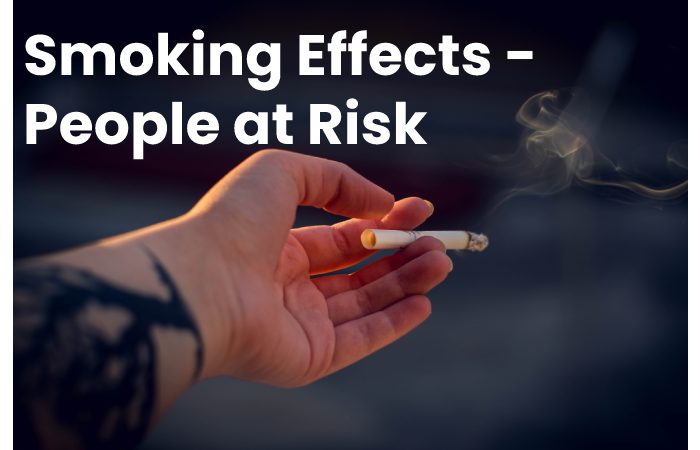Table of Contents
Introduction
Smoking Effects – The smoke of so-called “light” or “light” cigarettes is almost identical to that of conventional cigarettes. The “light” effect is essentially based on the presence of micropores in the filter. These allow the surrounding air to dilute the smoke and reduce the proportion of tar and nicotine inhaled. The efficiency of these filters is tested on machines that “smoke” at constant flow and power. Unlike the machine, the addicted smoker has neither a stopwatch nor a device to measure the volume of the puffs he inhales.
Also Read: kidney Disease – Introduction, Symptoms, Problems, and More
Effects of Smoking
Cigarette smoke contains over 7,000 chemicals. Among these substances, 69 are known carcinogens. Inhaled smoke travels through the human body and affects almost every organ. This is why smoking affects the health and well-being of smokers so much.
Other tobacco products, such as cigars and cigarillos, or the use of a water pipe also pose significant health risks. These are not safer options than smoking cigarettes.
The electronic cigarette is a special case. Its long-term health effects are still poorly understood, both for users and for people regularly exposed to vapors. However, e-cigarettes also appear to pose significant health risks. There are a wide variety of electronic cigarettes and currently their manufacture is not regulated by any standard in Canada.
Also Read: Fat Burning Menu – Introduction, Fat Burning Week Menu, and More
Smoking Effects – Addiction
Nicotine is a substance naturally present in tobacco and added to some electronic cigarettes. It is nicotine that causes addiction and physical dependence on tobacco products. A person can become addicted quickly, sometimes even before starting to smoke every day. Smoking 1 to 5 cigarettes a week can be enough to become addicted. Nicotine habit is comparable to that caused by heroin or cocaine use.
Pregnancy and adolescence are periods when the brain is actively developing. Thus, the nicotine to which a pregnant woman is exposed harms the optimal development of the brain of the fetus. A teenager’s brain development is also affected if exposed to nicotine. The negative consequences linked to nicotine are not necessarily perceived at birth or in adolescence, but in the longer term.
Smoking Effects – People at Risk

Therefore, Everyone is at risk of being affected by smoking or second-hand smoke. However, some people are more likely to be affected by second-hand smoke. Those are :
- pregnant women
- babies and children
- the elderly
- people with heart or breathing problems
- Smoking and Cancer
Smoking can cause cancer almost wherever in your body: mouth and throat (oral cavity and pharynx); Esophagus, voice box (larynx); Lung, bronchus and trachea; acute myeloid leukemia; Liver; Kidney and renal pelvis; Stomach; Cervix; Pancreas; Urinary bladder; colon and rectum.
Also Read: Obesity – Introduction, Types, Effects, and More
Smoking can cause cancer in your body:
- Bladder
- Blood
- Cervix
- Colon and rectum
- Esophagus
- Kidney and ureter
- Larynx
- Liver
- Oropharynx
- Pancreas
- Stomach
- Trachea, bronchus and lung
Also Read: Fat Burning Menu – Introduction, Fat Burning Week Menu, and More
Smoking Effects – Pregnant women
Smoking and exposure to second-hand smoke are main causes of health difficulties in pregnant women.
Pregnant females who smoke have a higher risk of:
Having an ectopic pregnancy (pregnancy located in the fallopian tubes);
Having placenta previa (placenta located in the lower part of the uterus) or a ruptured placenta;
give birth prematurely;
Give birth to a low birth weight, stillborn or malformed baby.
Smoking Effects – Babies and Children
Therefore, Smoking among family members and friends and exposure to second-hand smoke are major causes of health problems in fetuses, babies and children.
Babies and young children are particularly sensitive to second-hand smoke because their lungs are not yet fully form. Because children breathe faster than grown-ups, they are also more exposed to chemicals in secondhand smoke.
Babies and children visible to second-hand smoke are more likely to suffer from:
- cough
- asthma
- lung problems
- various infections
- pneumonia
- bronchitis
- otitis
Also Read: Home Remedies for Skin – 10 Tips for Smooth and Soft Skin
Conclusion
Therefore, Smoking is a major cause of disease, associated with a very strong health impact on the health of populations. It is the leading reason of preventable mortality, with an estimated 75,000 deaths in 2015, i.e. around 13% of deaths occurring in metropolitan France. On average, one out of two regular smokers dies as a result of their smoking.
Also Read: Halal Product – Introduction, Requirement, Demand, and More
